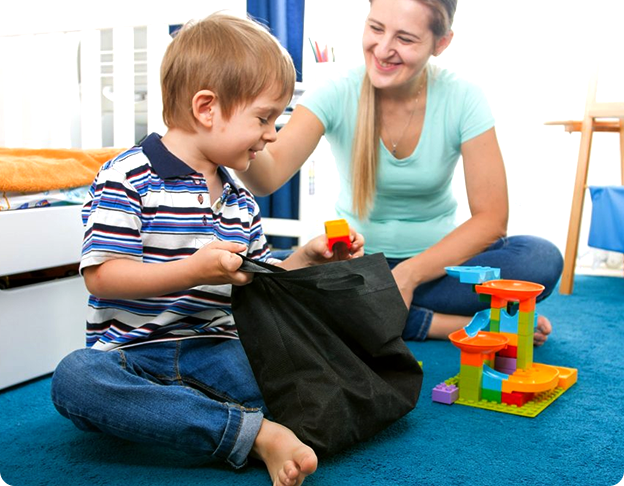While typically developing children acquire skills relatively quickly, for a child with autism, it can be a process. Sometimes even teaching basic skills for children with autism can be a challenge.
In Applied Behavior Analysis (ABA), therapists use a variety of tools to teach skills and promote good desirable behaviors. One such tool for teaching a new skill is Discrete Trial Teaching (DTT). DTT combines repetition with positive reinforcement to teach new skills.
The Basics of Discrete Trial Teaching (DTT)
DTT is one of the more structured tools in the ABA learning toolkit. It is a one-on-one session where a therapist, parent or teacher works with a child to teach something new. It is typically performed in a controlled environment that encourages focus. Often, the session will happen with the child and adult seated at a table with only the lesson resources and reinforcement items available.
The Discriminative Stimulus
In a session, each trial begins with the same cue, also known as a discriminative stimulus or instruction. It is a simple phrase that describes the intended behavior. For shape recognition, the cue might be, “Touch circle.” Phrases like “clap hands,” “thumbs up,” or “spin around,” can teach physical skills. “Do this” is a common cue for mirroring exercises.
The cue should not vary from trial to trial. When delivering the cue, the therapist speaks a little louder than their normal speaking voice. This tone helps draw the child’s attention.
The Prompt and Response
In early trials, the therapist delivers a prompt immediately after the spoken cue. If the cue is “Touch blue,” the therapist will tap the blue object. Then, they will wait for the child to respond. In a successful trial, the child will touch the blue object.
As the session progresses, the secondary prompt should begin to fade. Rather than touching the blue object, the therapist might point to it. The final goal is that the child will carry out the behavior with only the spoken cue.
Reinforcement and Error Correction
There are two outcomes for each trial. The child will perform the desired action or they won’t. With the correct response, the child is delivered an immediate positive reinforcement, and the therapist offers enthusiastic social praise for a job well done. Also, the child receives a tangible reinforcer such as a few seconds with a favorite toy, a high five or a small, sweet treat. This practice incentivizes learning and helps the child make positive connections with the desired behavior.
Therapists treat an incorrect response in two ways. Some will offer the child an informational “No.” They will speak the word in a neutral, nonjudgmental voice. Then, they repeat the cue and prompt, seeking the correct response. Other therapists will offer no reaction to an incorrect answer. They wait a few seconds and repeat the cue and prompt.
Repetition for Retention
DTT is an intensive learning process. The cycle of cue, action and reinforcement will repeat several times during the session. Once the child learns one behavior, the therapist can build on it in ensuing sessions. The child might practice the “Touch blue” action with a single blue object on the table until they achieve mastery. In a later session, the therapist increases the complexity of the task by adding items of different colors while still asking the child to, “Touch blue.”
The Five Benefits of Discrete Trial Teaching (DTT)
Discrete Trial Teaching helps children with autism learn and maintain new skills. Like other ABA techniques, it can significantly enhance a child’s developmental progress.
1. Clear Structure
The DTT structure creates a predictable framework for learning. As a child adapts to the technique, they will learn the pattern, and teaching sessions will become more productive.
2. Increased Attention
The DTT model helps children gain greater focus. The reinforcement experience at the end of a successful trial encourages a child to pay more attention to the overall process.
3. Flexible Model
As a one-on-one learning tool, a DTT session can happen in several settings including at home, school and outdoors. It is important to remember that this learning tool is an intentional process, so the adult must plan ahead in any setting.
4. Interactive Learning
DTT is an interactive process that can be implemented in many different settings, allowing easier transition between different settings. As an example, for children with autism, the transition from home to school may be a challenge. In addition to the new setting, there are also new teachers and aides. This teaching technique fosters the idea of working with an adult to learn new skills. When the pattern is used consistently, it will transfer from a home or clinic setting to the classroom.
5. From Simple to Complex
DTT is an effective tool for breaking complex learning into manageable pieces. Successful trials will boost a child’s confidence and help them get excited about learning new things
Start Collecting DTT Trial data Today
Download our beginner’s kit to learn how to collect DTT data on your own. Once you have collected this data, your healthcare provider will be able to analyze it and provide further strategies to improve these skills and maintain them. 




